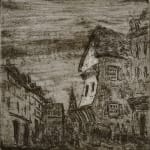Camille Pissarro (1831-1903)
Old Street in Rouen (Vieille rue à Rouen, Rue Malpalue), 1883
Etching and drypoint on antique laid paper
127 x 124 mm. (5 x 4 7/8 inches)
Signed in pencil & inscribed '1 Ep d’Etat'
Watermark 1826
Watermark 1826
Delteil 41 second (final) state
Delteil notes that there were only a few lifetime impressions of this print, only one impression of the first state and only two or three in the second state (there...
Delteil notes that there were only a few lifetime impressions of this print, only one impression of the first state and only two or three in the second state (there were also 8 posthumous impressions, which were stamped with the stamp signature and numbered). Pissarro’s annotation suggests that this is the first impression of what was to be the definitive state, but apparently only one or two others were made.
The bubbles from the ink left on the plate are still evident in the sky; as inked the impression has a cast of night, perhaps even a stormy night. Although the print is well within the Impressionist tradition, the great house also has an expressionist appearance – its facade juts in and out precariously as it rises.
Pissarro was perhaps the most active printmaker of the Impressionists; printmaking was an essential component of his career, and he was deeply involved in the process of creating and printing his prints. By mid-career Pissarro had made many etchings, using fairly conventional techniques (although of course aesthetically his work was hardly conventional), but it was Degas who introduced Pissarro to a range of unusual ways of working with the etching plate – especially the use of aquatint. At this point Pissarro was about 50. He worked closely with Degas for several years; they both enjoyed working carefully and painstakingly to refine an image or composition, and often incorporating accidents or unanticipated results in the print. Among other innovations, they developed a variant of the aquatint technique called “maniere grise”, in which they scraped the plate with an emery point; that technique appears to have been used in this print. As noted, Pissarro and Degas both loved to re-work their plates through several iterations, carefully giving the plates different shadings and nuances. The picture of the second state of Vieille Rue in the Delteil catalogue has a white sky, for example; quite different from this impression, but probably a difference created by inking rather than changes in the plate.
Pissarro did not like professional printing of his etchings, and so he printed his plates himself (also Degas apparently printed many Pissarro proofs). The concept was not to produce a large edition of prints similar in appearance (only about 5 of Pissarro’s prints were in fact editioned during his lifetime); printmaking for Pissarro was a way of experimenting, achieving variations in light, mood, sensibility, with each proof. He did not intend to earn much money through printmaking (and he never did).
In 1883 Pissarro was painting at Rouen, and returned to Paris with a number of sketches and full of recollections, which he used in developing the Rouen prints, which were probably completed in early 1884; Pissarro did not yet have a printing press of his own, so he used printing facilities in Paris. These are among his most engaging prints, and Vielle Rue a Rouen is among the most successful and interesting of this group.
The bubbles from the ink left on the plate are still evident in the sky; as inked the impression has a cast of night, perhaps even a stormy night. Although the print is well within the Impressionist tradition, the great house also has an expressionist appearance – its facade juts in and out precariously as it rises.
Pissarro was perhaps the most active printmaker of the Impressionists; printmaking was an essential component of his career, and he was deeply involved in the process of creating and printing his prints. By mid-career Pissarro had made many etchings, using fairly conventional techniques (although of course aesthetically his work was hardly conventional), but it was Degas who introduced Pissarro to a range of unusual ways of working with the etching plate – especially the use of aquatint. At this point Pissarro was about 50. He worked closely with Degas for several years; they both enjoyed working carefully and painstakingly to refine an image or composition, and often incorporating accidents or unanticipated results in the print. Among other innovations, they developed a variant of the aquatint technique called “maniere grise”, in which they scraped the plate with an emery point; that technique appears to have been used in this print. As noted, Pissarro and Degas both loved to re-work their plates through several iterations, carefully giving the plates different shadings and nuances. The picture of the second state of Vieille Rue in the Delteil catalogue has a white sky, for example; quite different from this impression, but probably a difference created by inking rather than changes in the plate.
Pissarro did not like professional printing of his etchings, and so he printed his plates himself (also Degas apparently printed many Pissarro proofs). The concept was not to produce a large edition of prints similar in appearance (only about 5 of Pissarro’s prints were in fact editioned during his lifetime); printmaking for Pissarro was a way of experimenting, achieving variations in light, mood, sensibility, with each proof. He did not intend to earn much money through printmaking (and he never did).
In 1883 Pissarro was painting at Rouen, and returned to Paris with a number of sketches and full of recollections, which he used in developing the Rouen prints, which were probably completed in early 1884; Pissarro did not yet have a printing press of his own, so he used printing facilities in Paris. These are among his most engaging prints, and Vielle Rue a Rouen is among the most successful and interesting of this group.



